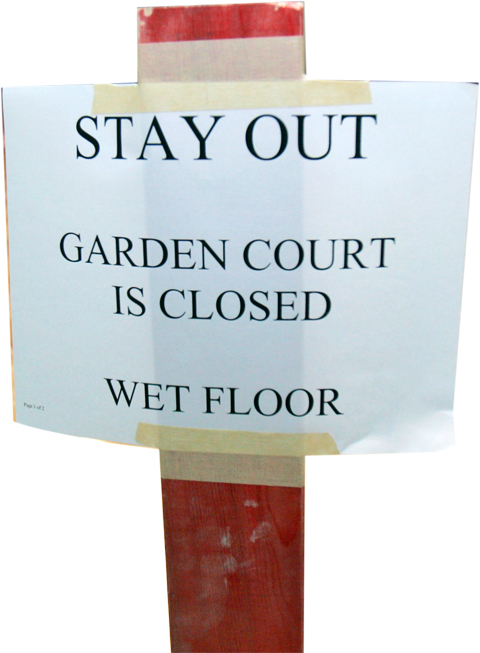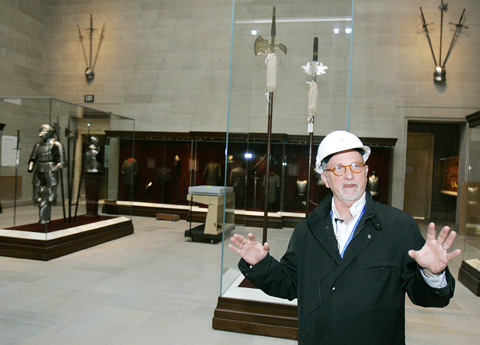Art museums throughout the US have gone on a construction binge as older institutions freshen up and expand and fast-growing cities, especially in America’s Sun Belt, tap into new wealth to show they have arrived in the art world.
Old or new, art museums also are striving to compete better with shopping malls and other leisure-time activities.
“Museums are in a transition moment,” said Anne Helmreich, associate professor at Cleveland’s Case Western Reserve University.

PHOTO: AP
The Cleveland Museum of Art is nearing the halfway point of one of the biggest projects, a seven-year, US$350 million expansion and renovation of a renowned institution that opened in 1916 with money from industrial magnates.
The museum, located in the city’s tree-lined University Circle arts and education district, on Sunday will reopen 19 galleries that have been closed for three years.
Elsewhere, the US$158 million renovation of the Detroit Institute of Arts debuted last fall, the Los Angeles County Museum of Art opened the US$156 million first phase of an expansion in February, the Art Museum of Western Virginia moves to a new US$66 million home on Nov. 8 and Sacramento’s Crocker Art Museum is working on an US$85 million expansion.

PHOTO: AP
Detroit’s renovation arranged European masterpieces to tell the story of an 18th-century grand tour of Italy. The Los Angeles project, part of a multiyear redesign of its 8.1-hectare campus, highlights the museum’s contemporary collection.
There’s more. In a survey last year involving 167 museums, the Association of Art Museum Directors said 66 percent were moving ahead with expansions, the highest share in three years. Most museums reported increased attendance, overall revenue and endowment income.
The construction surge amid a sour economy reflects the long-range planning involved. Museums often develop projects years in advance and have much of the needed money in hand from deep-pocketed donors before work begins.
Peter Yesawich, chairman of the Ypartnership travel industry marketing agency in Orlando, Florida, said museums can expect an attendance bounce with a new project, but it won’t necessarily last.
He said a museum facelift’s impact on attendance in a tight economy may depend on pricing, the public response and how long it takes to see the collections.
Still, the pattern of museum construction has spread across the nation, said Marc Wilson, director of the Nelson-Atkins Museum of Art in Kansas City, Missouri, which opened a US$196 million expansion last year. Planning began in 1993.
Wilson said the 75-year-old Nelson-Atkins, like Cleveland’s museum, needed updating and more space. In other, newer cities, art museums have sprung up as wealth migrates to fast-growing areas, especially the Sun Belt, he said.
The Art Museum of Western Virginia in Roanoke, Virginia, saw that happen, according to executive director Georganne Bingham. “What we’re seeing is people who are moving into the region are excited about the arts,” she said, including expanded museum memberships and donor rolls.
An art museum can reflect a community’s sense of having arrived, said Case’s Helmreich. “A city reaches a certain critical size, then you’ve got both the financial resources and also the intellectual resources, the community goodwill, to want to have a museum and support it.” A makeover also can reinvigorate old-line museums. The reopened museum at Detroit drew 400,000 visitors — normally a year’s worth — in six months.
“Many people have this extraordinary desire to connect with works of art,” said DIA director Graham W.J. Beal, who said people “do not want a mall-like experience” when they go to a museum.
In Cleveland, more than US$204 million has been raised for a project lasting into 2012, one year more than first planned.
The expansion and renovation will unravel a sometimes confusing labyrinth of galleries and corridors to create a more visitor friendly feel for what’s ahead in a museum with a collection of 43,000 items, including works by Rodin, Monet, Degas, Gauguin, Renoir and Van Gogh.
For art patrons, “It means that they’re not going to have to spend as much time figuring out where they are, that they’ll be reassured by what they can see ahead of them,” Jeffrey Strean, CMA director of design and architecture, said during a hard-hat tour.
That should relieve visitor fatigue, he said.
“Hopefully, we’ve built into the finished project places to stop — not only amenities — but places just to stop and rest, places to find out more, places to eat, places to shop,” he said.
World-class art must compete with shopping malls and “every other sort of entertainment for folks these days,” Strean said.
“We have to kind of make it as unobstructed and comfortable a thing as it can be.” But the art always comes first, according to Wilson of the Nelson-Atkins.
“If you do not have in some way on your terms a meaningful relationship in those galleries, with works of art, the coffee isn’t enough to bring you back,” he said. “There are too many places where you can get coffee today.” Part of that transition is a trend toward making museums more community friendly, reflecting local interests and traditions, such as the southern Appalachian music and crafts programming of the Roanoke museum. The goal is to attract visitors and keep them for longer stays.
“Museums are very complex institutions,” said Saul Ostrow, who teaches at the Cleveland Institute of Art. “They are not just warehouses, storehouses of art. They are educational institutions, they are social, they bring people together. They imbue values and standards to the community. They offer a whole other range of experiences.”

Taiwan Power Co (Taipower, 台電) and the New Taipei City Government in May last year agreed to allow the activation of a spent fuel storage facility for the Jinshan Nuclear Power Plant in Shihmen District (石門). The deal ended eleven years of legal wrangling. According to the Taipower announcement, the city government engaged in repeated delays, failing to approve water and soil conservation plans. Taipower said at the time that plans for another dry storage facility for the Guosheng Nuclear Power Plant in New Taipei City’s Wanli District (萬里) remained stuck in legal limbo. Later that year an agreement was reached

What does the Taiwan People’s Party (TPP) in the Huang Kuo-chang (黃國昌) era stand for? What sets it apart from their allies, the Chinese Nationalist Party (KMT)? With some shifts in tone and emphasis, the KMT’s stances have not changed significantly since the late 2000s and the era of former president Ma Ying-jeou (馬英九). The Democratic Progressive Party’s (DPP) current platform formed in the mid-2010s under the guidance of Tsai Ing-wen (蔡英文), and current President William Lai (賴清德) campaigned on continuity. Though their ideological stances may be a bit stale, they have the advantage of being broadly understood by the voters.

In a high-rise office building in Taipei’s government district, the primary agency for maintaining links to Thailand’s 108 Yunnan villages — which are home to a population of around 200,000 descendants of the Chinese Nationalist Party (KMT) armies stranded in Thailand following the Chinese Civil War — is the Overseas Community Affairs Council (OCAC). Established in China in 1926, the OCAC was born of a mandate to support Chinese education, culture and economic development in far flung Chinese diaspora communities, which, especially in southeast Asia, had underwritten the military insurgencies against the Qing Dynasty that led to the founding of

It’s fairly well established that strength training is helpful at every age: as well as building muscle, it strengthens tendons and ligaments, increases bone density and seems to have protective effects against everything from osteoporosis to dementia. But a new study based on data collected over two decades in Rio de Janeiro, Brazil, suggests that another physical attribute might be just as important — and it’s one that declines even faster than strength as the years go by. The good news? It might also be less uncomfortable, and even slightly safer, to improve. Also, it will probably make you better